
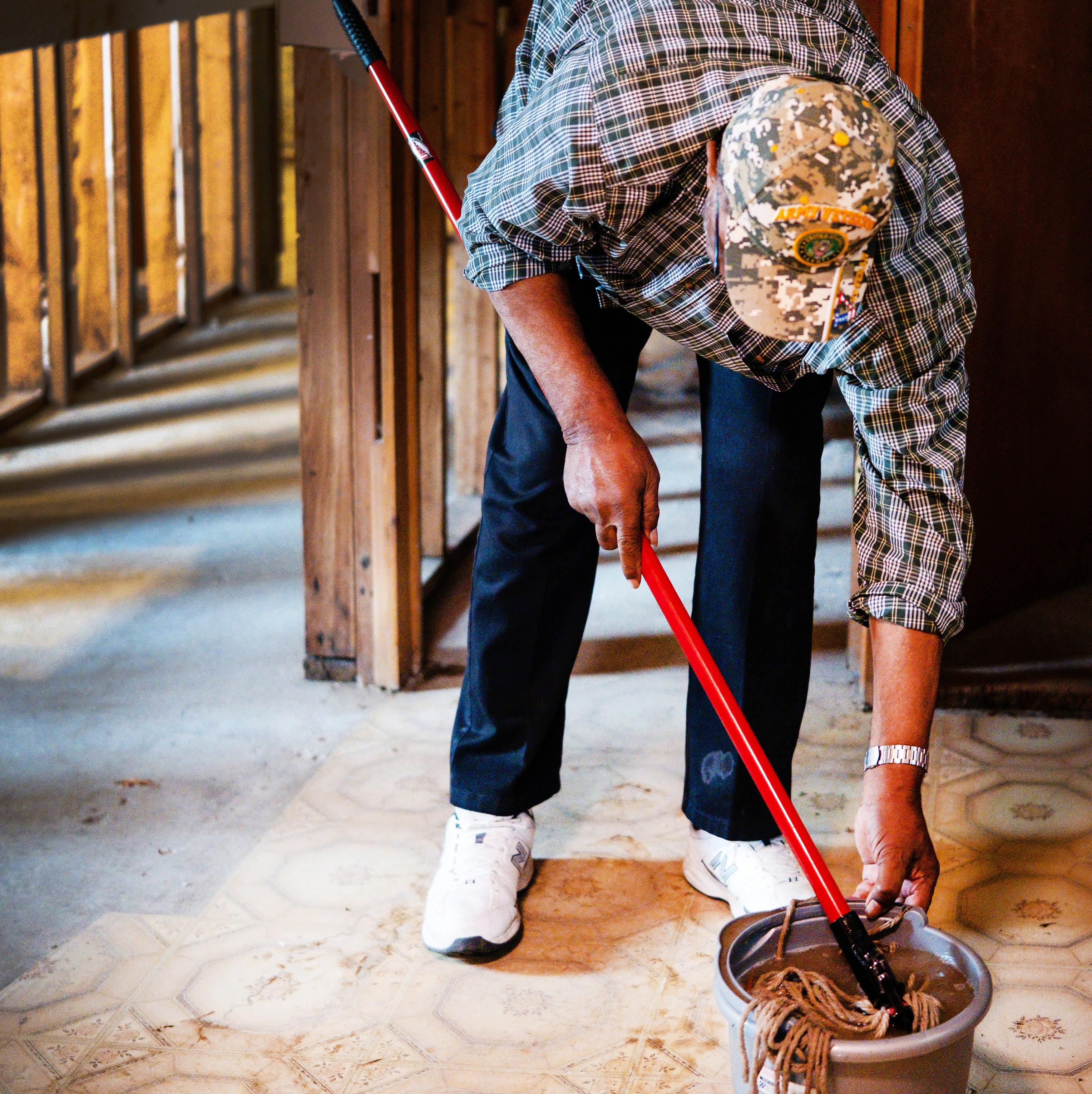



It’s been almost a year since thousands of Westside basements were destroyed by water, but what does genuine recovery look like against the backdrop of ongoing disinvestment and exploitation?
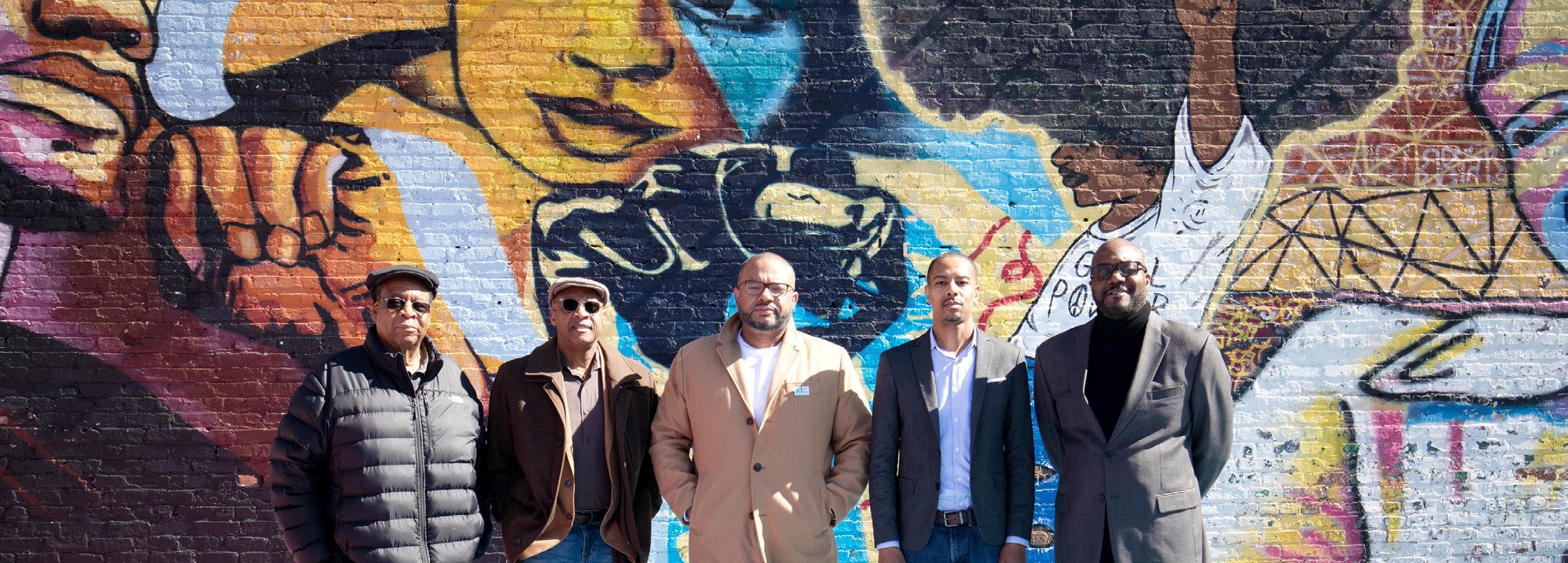
‘We wish to plead our own cause, too long have others spoken for us’By Michael Romain Editor
In 1826, a group of free Black men gathered at the New York home of M. Boston Crummell. Their task was to figure out a way to improve the quality of life for other Black people. They decided that the best approach would be to start a newspaper. A year later, they launched Freedom’s Journal, the first Black-owned newspaper in American history.
“We wish to plead our own cause,” the newspaper declared in the inaugural issue. “Too long have others spoken for us. Too long has the public been deceived by misrepresentations in things which concern us dearly.”
Nearly 200 years later, a group of five Black men met in a Westside office and reached the same conclusion. Too long has the mainstream media misrepresented the things that concern the Westside dearly. We wish to plead our own cause.
The Culture is the result of a series of conversations and working meetings among this group, which includes:
● Morris Reed, the CEO of Westside Health Authority
● Karl Brinson, the president of the Chicago Westside Branch NAACP
● Bernard Clay, executive director of Introspect Youth Services
● Frank Latin, the executive director of the Westside Media Project
● Michael Romain, the publisher of Village Free Press and communications director for Westside Health Authority
Like Freedom’s Journal, the Culture is designed to enhance the media ecosystem on the city’s Westside and be a conduit for Westsiders to tell their own narratives and plead their own causes.
The Culture is also a vehicle for community members to learn about critical resources, trending careers, job opportunities, and social services offered by a range of Westside institutions, particularly WHA’s Good Neighbor Campaign.
We hope that this publication helps counter widely held misperceptions about the Westside that are dominant in mainstream media outlets and local media outlets that aren’t inclusive of Westside perspectives.
As the name suggests, the Culture is not a newspaper in the strict sense; it’s something more. That more, that beyond is reflected in the drum symbol that’s in our logo.
European or western news dates to the medieval period in the 1400s, when a commercial news market was the prerogative of
political elites. Despite its relative democratization, western news has continued to be the prerogative of political elites.
Instead of looking to western news and it’s mythic ideal of objectivity as a model, The Culture locates our news and narrative framework in the concept of the talking drums of sub-Saharan Africa.
Those drums allowed community members to communicate elaborate messages (their “news”) over long distances through drum beats. At one point, they were among the world’s fastest and most efficient mode of communicating, and they were forms of communication owned and controlled by community members working collectively for a common cause. Those drums were rooted not in the profit motive, but in people.
Like the talking drums of sub-Saharan Africa, The Culture will be grounded in the Westside’s multiethnic, class-diverse community; and yet rooted in African-oriented ways of knowing and seeing ourselves: our unique speech, our traditions, our dances, our art, etc.
We hope you’ll see yourselves in this community endeavor, so please reach out to us. We’re currently in the process of building out our website. In the meantime, if you have story ideas or want to share helpful information, please email me at mromain@healthauthority.org.
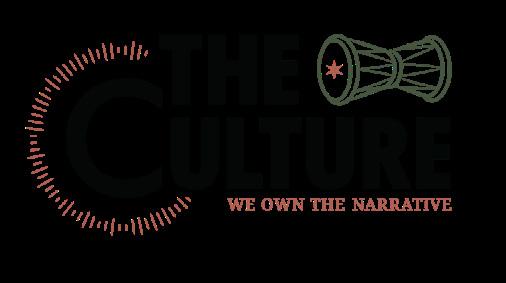
Michael Romain Communications Director
Frank Latin Communications Specialist
Kenn Cook Jr. Communications Specialist
Kamil Brady Circulation Manager/Sales
Kyler Winfrey Digital Media Specialist/Good Neighbor Campaign liaison
Trey Arline Reporter
Asante Hayes Photographer/Videographer
Jihoon Woo Photographer/Videographer
Paul Goyette Photographer
Nora Bhuiya Layout Designer
Morris Reed Westside Health Authority/CEO
Karl Brinson
Westside Branch NAACP/President
Bernard Clay Introspect Youth Services/Executive Director
Frank Latin Westside Media Project/ Executive Director
Michael Romain Village Free Press/Publisher CONTACT US
at mromain@healthauthority.org
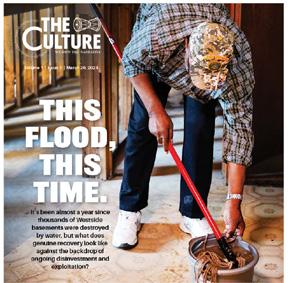
Call Good Neighbor’s Help Line: The Good Neighbor Campaign is a movement to connect neighbors and empower each other through sharing our gifts, talents, and abilities. Do you need assistance or support? Call our new Good Neighbor Help Line at (312) 219-8864 (Ext. 2400).
Still Recovering From The 2023 Flood? Get
Some Help: If you’re still recovering from last year’s flooding and need support, please reach out to the West Side Long-Term Recovery Group. The group’s volunteer case managers work with residents to assess the damage to their homes and understand the relief options available to them before deploying volunteer contractors to begin waste removal/muck out, mold remediation and rebuild. For more info, visit westsideltrg.com/ or call (773) 909-8502.
Get Free Credit-Building Support: The Westside Health Authority is excited to offer FREE financial and credit-building counseling in partnership with Tzedek DC and Work-

ing Credit, a nonprofit that provides expert credit-building workshops and confidential, one-on-one financial counseling for a year. Get help with finding the best interest rates, tacking your debt, gaining access to quality rental housing, building a safety net and much more. Sign up at info.workingcredit. org/join/tzedekdc. For more info, call (773) 275-0900 or email info@workingcredit.org
Learn About Home Improvement: The Westside Health Authority will present a FREE DIY Home Repair Workshop Series hosted by Tyrone Day starting Saturday, April 13, 11 a.m. to 1 p.m., at the Good Neighbor Center, 5437 W. Division. Learn how to install lighting, ceiling fans and video doorbells, as well as how to do light electrical repairs. You’ll need the information some day! For more info, call (773) 378-1878.
Make Your Voice Heard On Harm-Reduction: Share your thoughts on harm-reduction services on the Westside in a new online survey that’s part of aproject led by the West
Side Heroin/Opioid Task Force and IDHS/ SUPR. They want to learn how harm-reduction services can reduce drug overdoses on the Westside. The survey is anonymous and confidential. Results will help them understand what harm-reduction services Westsiders think we need. To take the survey, visit redcap.vanderbilt.edu/surveys/?s=A7DAWTXPC8YTJNXC. To learn more about the West Side Heroin/Opioid Task Force, visit facebook. com/westsidetaskforce2020, call (773) 4501567 or email Task Force Outreach Coordinator Lu Syas at luther.syas@yahoo.com.
Artists Share Your Mural Proposal: Don’t forget the deadline for submitting proposals for the Aspire Center Mural is 5 p.m. on Friday, March 22. The Aspire Center for Workforce Innovation is a joint venture of Austin Coming Together and Westside Health Authority to renovate and repurpose the former Robert Emmet Public Elementary School into a space where multiple organizations can work in collaboration, intersect programmatic initiatives and provide ser-
vices to residents from one central location. Read more about the Aspire Center at austincomingtogether.org/aspire-center/. We’re looking for artists to plan and execute a mural design that will be placed on the exterior wall and wrap into the indoor public lobby and atrium space. We will be making selections based not only on designs but also on community engagement. Final proposals must be submitted to Natalie Goodin at ngoodin@austincomingtogether.org, with a copy to Alyssa Krause at alyssak@pmainc.com.
Get Some Automotive Training: Start a career in the transportation industry with a 12-week general automotive training by Fast Lane Automotive Training hosted by BUILD Chicago. Learn to inspect, diagnose, repair and more. Join BUILD on Thursday, March 21, 5:30 to 6:30 p.m. at the BUILD Performance Hall, 5100 W. Harrison St., to learn more about the opportunity, which includes handson learning, job placement, certification and more. You must be at least 17 years old. For more info, call (773) 227-2880.
Thanks to a new law that took effect Jan. 1, 16-year-olds can now pre-register to vote
By Trey Arline ContributorAlthough voting is only legal for citizens 18 and older, 16-year-olds can now pre-register to vote online through the Illinois State Board of Elections website.
As part of a new law that went into effect Jan. 1, 16-year-olds can have their application held until voting age as part of their driver’s license applications. According to a March 6 report by WTTV, 3,500 teenagers in the state have pre-registered to vote this year.
Here’s how it works and why this law will have an impact:
Are 16-year-olds able to vote because of this?
No, you still must be 18 to cast a ballot in any election. Your voting application will be held until then.
Can 17-year-olds vote in any capacity?
Yes! To vote in the upcoming 2024 elections, you must be 17 years old on or before the date of the primary election on March 19 and turn 18 on or before the date of the Nov. 5 general election.
What’s on the ballot for the primary in Illinois?
The 2024 primary will have voters decide on the nominees for president, U.S. House races,
Cook County State’s Attorney, the Illinois Supreme Court, Cook County Clerk of the Circuit Court, Illinois Appellate Court, and the Bring Chicago Home tax referendum that would redistribute funds from the Real Estate Tax Fund to housing and crime prevention programs.
Where can people sign up to vote?
The online portal to vote can be found at the Illinois Board of Elections website (https://ova.elections.il.gov/RegistrationClosed. aspx), but voting for the 2024 primary has closed. Voters may still register in person at an early voting site or their election day polling place if they present two forms of valid ID. Online registration will resume March 21.
What is the benefit of this law being passed?
It hopefully will encourage young people to vote when they become adults. Youth turnout has been historically low nationwide for decades. According to the Chicago Sun-Times, 3% of voters in the 2023 Chicago municipal elections were between 18 to 24-years-old. This is despite the fact that 15% percent of the city’s population is between 15 and 24-years-old, according to Census data.
Why is it so hard for young people to vote?
This is a multifaceted issue that has been asked across generations. But many reasons include lack of transportation, no time off from work or school, inconsistent ballot requirements for college students,
lack of outreach, and other forms of voter suppression. Many young people often believe their votes do not matter enough to change the outcome of an election.
Is there hope things could change?
Absolutely! Youth turnout has become significant in recent elections. According to voting rights group Circle, youth turnout increased from 39% in 2016 to 50% in 2020. The largest driving force of those numbers come from young women.
Where can I find a place to vote?
You can look at the Illinois State Board of Elections website (ova. elections.il.gov/PollingPlaceLookup.aspx). Enter your address and the website will find the closest polling location near you.

For the 83-year-old Westside homeowner, last year’s flooding reminded her of a prediction a precinct captain made in the 1960s
By Michael Romain Editor“Everything now, we must assume, is in our hands; we have no right to assume otherwise. If we — and now I mean the relatively conscious whites and the relatively conscious blacks, who must, like lovers, insist on, or create, the consciousness of the others — do not falter in our duty now, we may be able, handful that we are, to end the racial nightmare, and achieve our country, and change the history of the world. If we do not now dare everything, the fulfillment of that prophecy, re-created from the Bible in song by a slave, is upon us: God gave Noah the rainbow sign, No more water, the fire next time!”
— James Baldwin, “The Fire Next Time,” 1963In 1965, just two years after James Baldwin published those words, Queen Esther Jackson moved into a two-story graystone at 4251 W. Gladys Ave. in West Garfield Park.
She and her husband were going through a painful divorce. Facing the prospect of being single again, she thought about walking away from the new home. At the time, whites were leaving the Westside in droves and Blacks were moving in.
“I’ll never forget this precinct captain telling me, ‘Look, we running now, but we coming back,” Queen says. “I will never forget him telling me that. At the time, I didn’t pay it too much attention. My thing was just getting out of the [marriage]. But that precinct captain said, ‘Don’t leave, stay. We coming back.’ I will never forget that.”
Queen stayed, pouring money and time and energy into renovating her home, which was built in 1900. She stripped paint off the detailed trimmings in her first-floor living room so that the original woodwork was exposed again. She even purchased her neighbor’s graystone next door at 4249 W. Gladys Ave. in 2005, the year she retired from Federal-Mogul Corporation, an auto parts manufacturer in Skokie.
“I was working and I had a line of credit,” she says, when asked how she managed to pay for the improvements and purchase an-
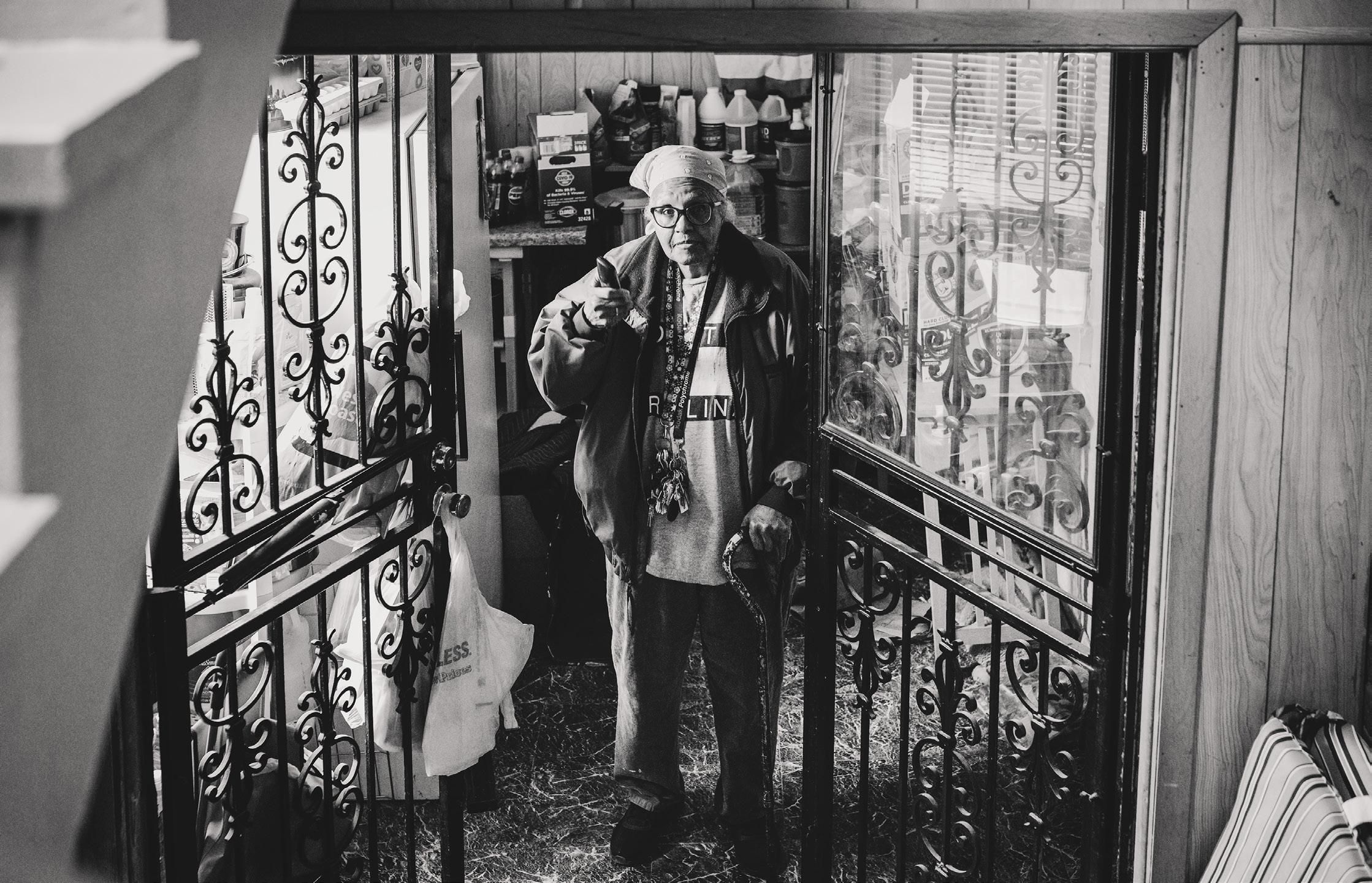
other building on a blue-collar salary.
“As a matter of fact, I still owe about $30,000 as a line of credit to Chase. You work hard, living from paycheck to paycheck, doing what you have to do. It wasn’t easy. It still ain’t easy.”
Queen was vigilant about keeping her basements dry. Nearly 20 years ago, she installed flood control systems in the frontyard of each of her properties. But on July 2, 2023, after the Westside got up to eight inches of rain, water flooded both her basements anyway.
Now, nearly a year after the flash flood, the basement of Queen’s rental property still sits empty and the basement of her primary residence, where her grandson lives, has mold.
She’s used the roughly $13,000 she received from the Federal Emergency Management Agency (FEMA) to replace appliances that were destroyed in the flood, including a hot water tank and a furnace. She paid $37,000 for a contractor to rip out the molded walls in the rental building, among other work. But she estimates that she’ll need another $25,000 to $30,000 to completely renovate both basements.
Queen, 83, contemplates the white precinct captain’s prophecy while looking out of her rental unit’s basement window at the
flood control system she installed decades ago, to no avail.
From her vantage point, we have not achieved our country. The country — along with the city and the state — have let her down. The very forces of racism, prejudice and predatory capitalism are as palpable today as they were six decades ago when Baldwin warned about them and are threatening to overwhelm Queen’s vigilance and best efforts.
To file her insurance claims, Queen needed an appraisal, but contractors wanted to charge hundreds of dollars for each estimate. One contractor who charged her $450 “told me if he didn’t get the job, he wouldn’t do [the appraisal]. I told him, I
don’t know if I’ll get any money or not! Just goes to show you how they’re out there trying to rip people off.”
And in the months after the water receded, Queen discovered the roof of her primary residence was damaged, water leaking through the ceiling tiles. She filed a claim for the roof with State Farm, her homeowner’s insurance provider, but was denied.
“Let me tell you what happened,” she says. “I filed an appeal for the roof. I told FEMA the insurance wouldn’t cover it. So FEMA called the insurance. Now, my insurance is canceling me because I had already filed a claim [for something] in 2007 and they didn’t pay me nothing. [...] They didn’t pay me nothing but they’re canceling me! I think that’s very low down what they’re doing to people. As much insurance as we pay! I think it’s modern-day redlining.”
We don’t know the precise details of her policy cancellation (which Queen is also appealing with the help of community organizer Princess Shaw), but her suspicion of redlining, the practice of denying insurance and loans to people based on the racial makeup of where they live, is rooted in both historical memory and hard evidence.
“Back then, most of the buildings [on the Westside] had two apartments on the second floor,” Queen recalls of her days living in West Garfield Park in the 1960s. “They made us Blacks combine them into one apartment, but the white folk had two. They made us take [the second apartment] out. It just goes to show you how they design stuff


for the white folk to make money, but not the Blacks.”
Contrast Queen’s experience with that of Linda Gartz, a white woman whose family lived in West Garfield Park in the 1960s. In “Redlined,” her 2018 memoir, Gartz writes about her family’s move to a two-flat at 4222 W. Washington Blvd.
“A single family occupied the first floor,” she writes. “On the second floor, a seventy-year-old woman held the lease and rented out two of the four bedrooms. Subletting
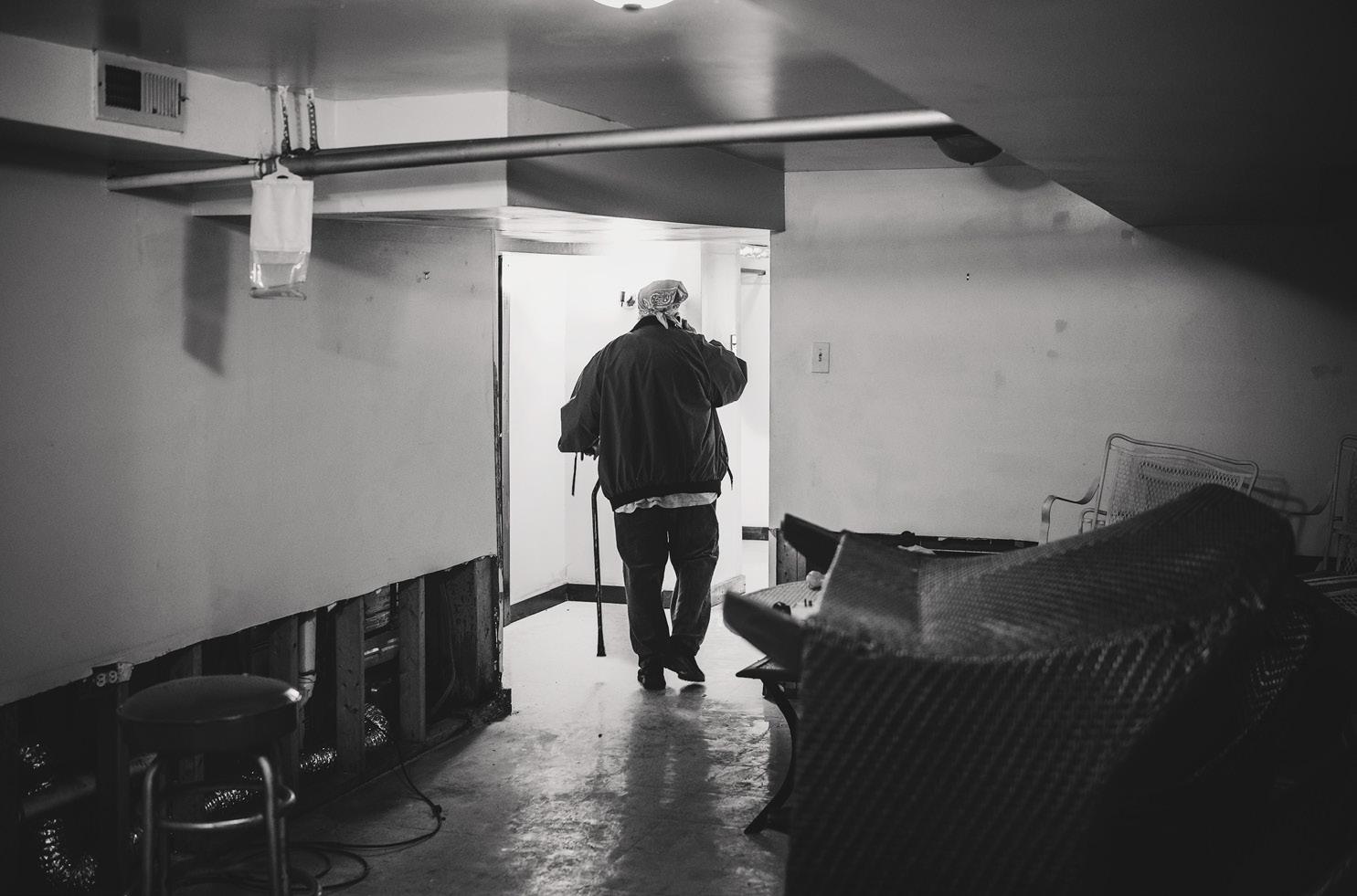
was against building code, but for many it was an easy way to make ends meet. If Chicago building department inspectors snooped around, a show of cash usually made them go away.”
Blacks harassed by code inspectors didn’t have recourse to that kind of petty corruption. In the 1960s, many new Black homeowners were actually leasing their houses from predatory real estate agents who would arbitrarily add extra fees to already overpriced monthly payments. Blacks were also frequently harassed by housing code inspectors who would order them to make costly changes that only added to the white landlords’ fees while pushing Blacks closer to eviction.
Farm of “violating the 1968 Fair Housing Act by forcing Black policyholders to wait longer than their white counterparts for their claims to be approved,” the Courthouse News Service reported.
The lawsuit “further alleges, using data drawn from 800 white and Black homeowners across the Midwest, that Black customers were 39% more likely than white customers to be asked to submit additional paperwork after filing a claim, and 20% more likely to need more than three meetings with State Farm employees in order to settle one. The additional hurdles Black customers have to clear in turn causes them to wait longer for necessary home repairs.”
On the wall of a storage room adjacent to Queen’s kitchen hangs a portrait of Martin Luther King Jr., who moved into a rundown apartment in North Lawndale in 1966 to bring awareness to the economic and racial injustices ravaging Chicago, particulary the Westside.
King thought he could use the strategies that worked in the South to win victories in the North. But Chicago organizers like Saul Alinksy had doubts about King’s approach.
“Look, we running now, but we coming back.”
“In the North you need a more sophisticated approach,” Alinsky told a magazine reporter in the 1960s. “The segregated practices in the South are a kind of public butchery. It’s visible. There’s bleeding all over the place. Up here we use a stiletto, it’s internal bleeding, it’s not visible, but it’s just as deadly.”
Alinsky might well have replaced the stiletto with paperwork — perhaps the State Farm cancellation notice Queen received earlier this year — as an appropriate metaphor to describe systemic racism’s lethal stealth in cities like Chicago. He could also have used mold.
And as more and more Black families replaced white families in areas like West Garfield Park, the more risky and uncreditworthy the area was deemed by private realtors and the federal government. It was a vicious cycle that is still spinning.
In 2022, a group of Black homeowners who hold home insurance policies with State Farm filed a federal class action lawsuit against the company. They accused State
“There’s mold right next to the refrigerator and behind the couch and underneath the cabinets over there,” Aaron Barnes, Queen’s 22-year-old grandson, says during a tour of his basement apartment.
Meanwhile, as the mold grows and local, state and federal governments stall, Queen fields regular calls from eager investors asking if she wants to sell her home. After all, West Garfield Park is a buyer’s market at the moment.
“They call every day,” she says. “Every day. They’re trying to get back in here. They know what’s happening.”
“Everything now, we must assume, is in our hands; we have no right to assume otherwise.”
— James Baldwin, “The Fire Next Time,” 1963
Mary Buchanan, 68, was one of the thousands of Westsiders who called 311, the city’s non-emergency service request line, in the days, weeks and months following the flash flood on July 2, 2023.
“The city ain’t do nothing! We didn’t get no help calling the city,” Mary says nearly a year later while walking through the empty, hollowed out basement of her home at 4228 W. Jackson Blvd. As Mary vents, her husband, George Johnson, 80, mops the floors.
Other flood survivors say the city at least sent over crews to help haul out things that were damaged from their basements, even if the workers came months later.
But the Westside flood survivors we interviewed say the most significant assistance they received in the flooding’s aftermath came from a small group of local organizers working out of the Every Block a Village Christian Fellowship church at 5834 W. Augusta Blvd. in Austin.
The church’s pastor, Jacqueline Reed, founded the nonprofit Westside Health Authority (WHA) in 1988 and anchored the organization’s mission in the principle that the best solutions to people’s problems are the people themselves — not consultants or professional experts or bureaucrats or academics.
Each Thursday morning for the last two years, Reed has held community meetings where residents workshop solutions to any number of crises. Naturally, after July 2, dozens of community members converged on the church to talk about the water and all the problems that came with it.
From the Thursday gatherings, more emergency meetings followed while local organizers and community leaders pushed for local, state and federal officials to declare the Westside and other places affected by flooding a disaster area. This is often the first step that needs to happen before people can start applying for assistance from the Federal Emergency Management Agency (FEMA).
“We were in regular communication with Mayor Johnson,” recalls Jitu Brown, who heads the 1,000 Strong Block Club and helped organize those meetings.
“We were holding really grassroots town

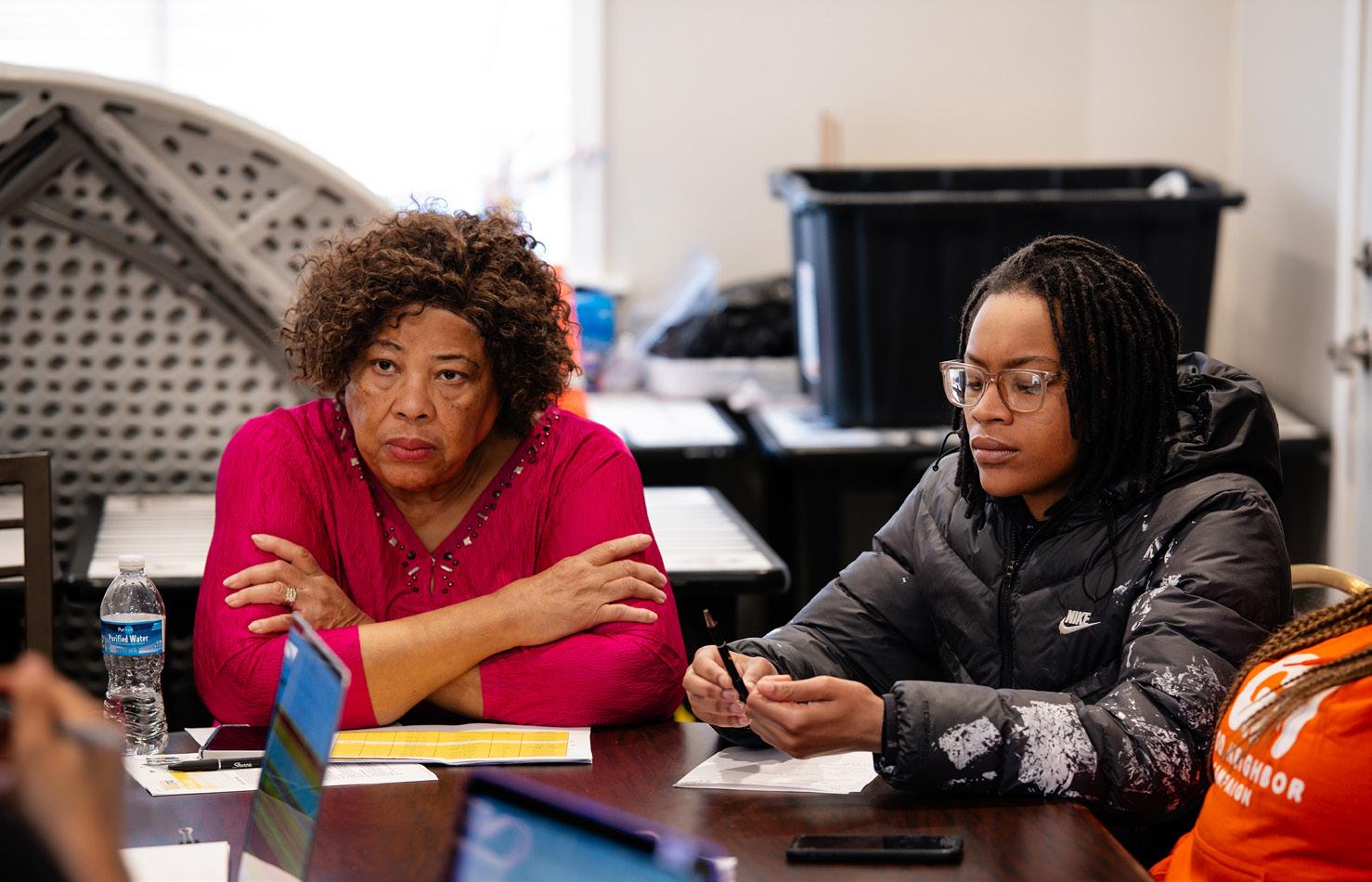
After last summer’s flooding, Westsiders came together to help themselves, but frustrations are growing over a lack of fundingBy Michael Romain Editor
hall meetings. We did a town hall meeting in the middle of the street on Division. We did one at La Follette Park. These were working meetings. We didn’t want people giving speeches; we were doing client services,” he says. “My block club was [aslo] doing cleaning supply giveaways on Division and Long.”
A few weeks after the flood, the Good Neighbor Campaign, a community-building, anti-violence initiative launched by WHA in 2016, teamed up with local organizers like Jitu and state Rep. La Shawn K. Ford (8th) to hold a public meeting about flood relief at the Good Neighbor Center,
head of FEMA’s community relations and we were just pressuring every angle we could.”
President Joe Biden approved a major disaster declaration for Illinois on Nov. 20. After that point, Jitu says, “it was about managing and organizing to make sure we could maximize FEMA’s investment.”
Princess Shaw, the founder of Light Up Lawndale, a nonprofit whose purpose is to provide economic empowerment to the Lawndale community, was one of the main organizers navigating people through FEMA’s application process.
“When this first happened, the city told people to call 311 and make a report,” Princess says. “That’s a 59-page report. What has the city done with those reports? We don’t know. But we can’t just sit around and wait for them to tell us.”
To further complicate the process, people had to apply for FEMA assistance separately, forcing them to enter yet another bureaucratic maze.
“None of the [processes] filtered into each other,” Shaw says. “You have different systems and they aren’t working together with each other. That’s how you lose people.”
Princess says FEMA informed her and other organizers that they should establish a LongTerm Recovery Group. According to FEMA’s website, long-term recovery groups “generally are made up of faith-based, nonprofit, community-based, private sector and voluntary agencies. Their goal is to help affected families access resources for their recovery.
“The recovery groups can connect survivors with organizations that offer a wide variety of assistance, including food, clothing and grants to help pay for security deposits and past-due utility bills. They can also direct survivors to groups that will perform tasks, such as mucking and gutting disaster-damaged homes or clearing debris and tree stumps from yards.”
Local organizers like Darnell Clark and Roman Morrow, along with organizations like the Leaders Network, a prominent coalition of Westside clergypeople, also provided awareness by hosting press conferences and public meetings.
“I’m never of the mindset, ‘If you’re doing good, I’m trying to compete with you,’” Jitu says. “If you’re doing good, I’m locking arms with you because we need as many warriors as we can get.”
As WHA was doing local advocacy, Jitu says, “I was in Washington, D.C., meeting with the
That’s how the West Side Long-Term Recovery Group (LTRG) was born. It’s parent organizations include WHA, Light Up Lawndale, Every Block a Village, BUILD, Inc., World Renew, Team Rubicon, Illinois Voluntary Organizations Active in Disaster, Chicago Tool Library and Northwest Austin Council.
“We started the West Side LTRG because we don’t want to have people falling through the cracks and living with mold in their basement,” Princess says.
Princess says the group’s constant interactions with community members allowed them a bottom-up, grassroots perspective to tasks like hauling all of that flood-damaged stuff from basements.
“We were able to galvanize and get Streets

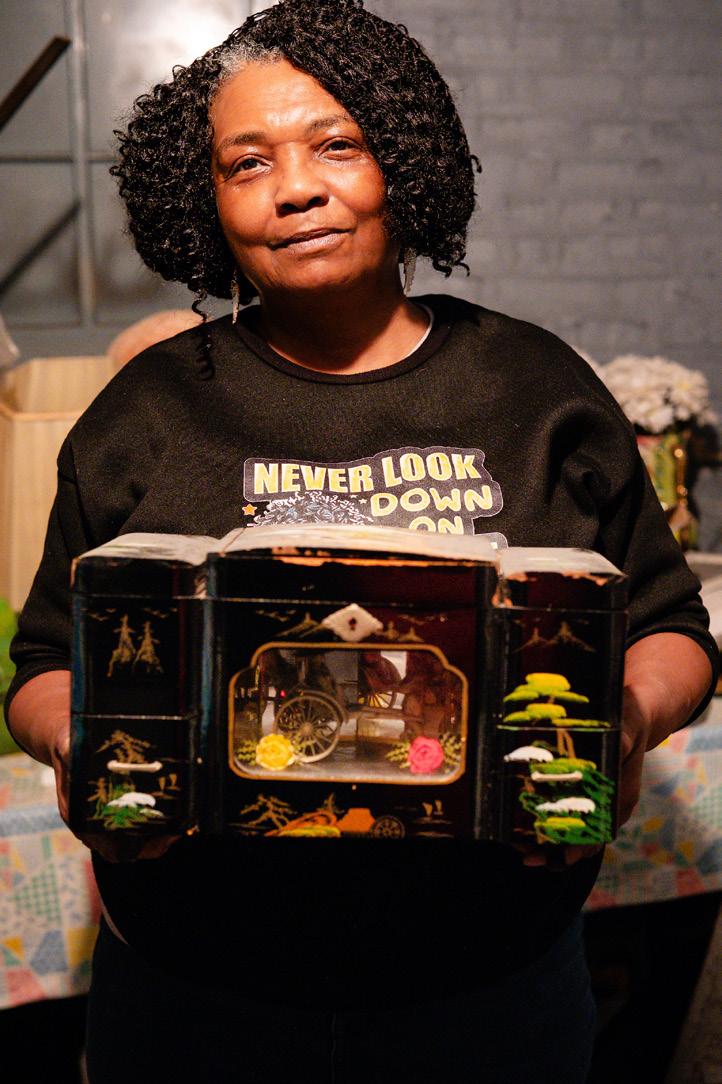
Since the West Side LTRG’s formation, Princess and WHA’s policy analyst, Justin Hill, have kept a list of 250 flood survivors who need help. Princess says she would like city, state and federal government officials to step in and start vigorously monitoring flood survivors and their needs.
Jitu and other organizers also want the city to contribute between $25 million and $50 million in special funding to help survivors pay for flood-related improvements that FEMA and their insurance didn’t cover. Princess says the West Side LTRG can be the conduit for those funds being allocated to affected community members, but added that the amount might have to be higher.
“The $50 million is an average guesstimate based on what we’ve seen so far,” Princess says, adding that the average Westside household affected by the flood may need another $25,000 to $30,000 to pay for repairs not covered by their FEMA payouts. “There’s definitely 16,000 to 17,000 people affected in this area, which includes Austin, Garfield Park, Galewood, Lawndale and Humboldt Park.”
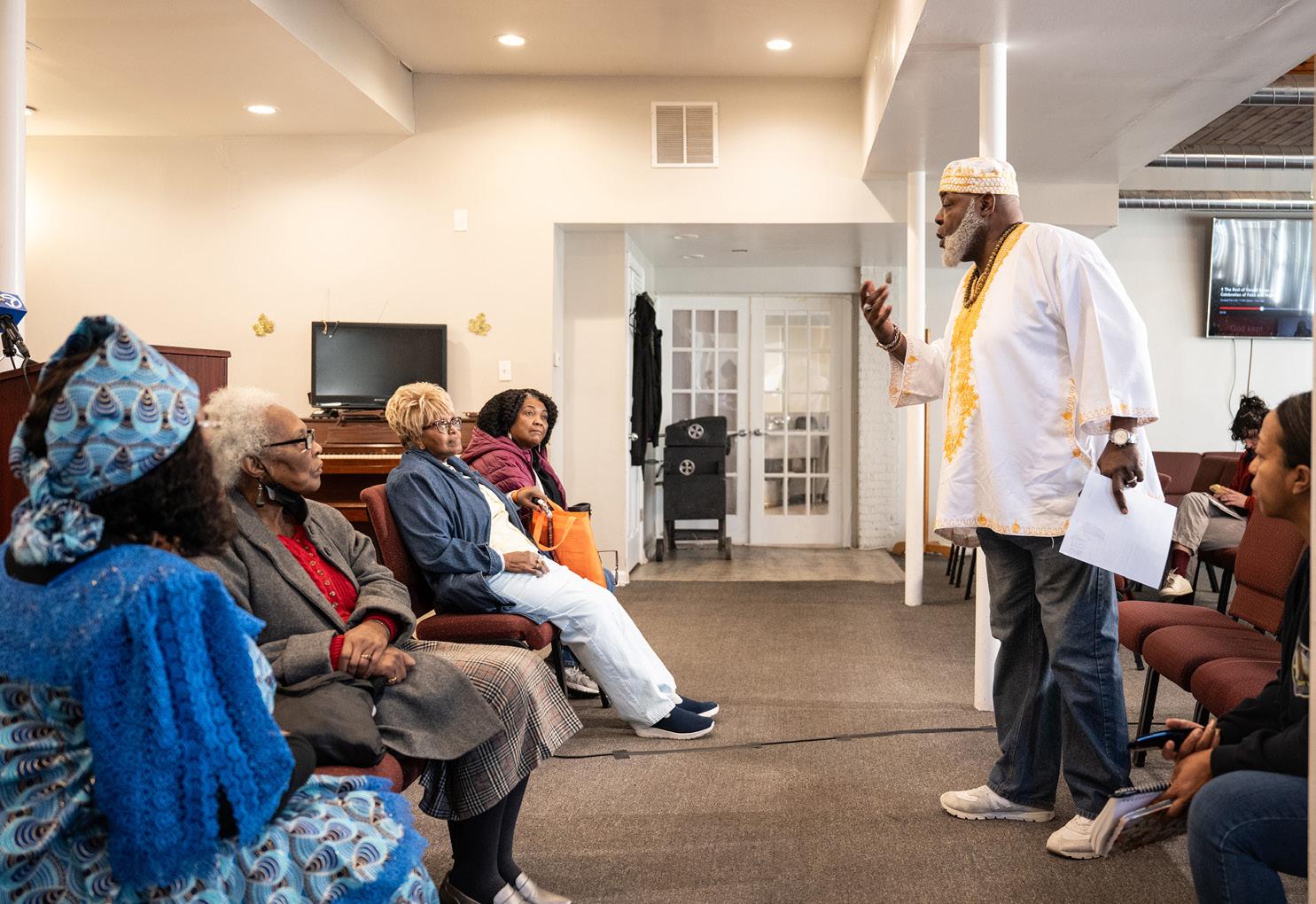
and Sanitation workers [who checked with their union reps first] to come out for three weekends at the end of July and the beginning of August to take stuff out of basements,” Princess says. “Our advocacy told them that many of these [flood survivors] are older. They put a lot of that stuff in their basements 20 and 30 years ago, when they didn’t have bad hips and arthritis. So, we just had those realistic conversations like, ‘Hey, let’s think outside of this box.’”
In the meantime, Princess, Jacqueline and other West Side LTRG members are slowly but deliberately checking their list. Mary Buchanan is fortunate to have been on it.
Mary says Princess helped her file around four appeals with FEMA to get more money to replace critical appliances she lost in the flood, including a furnace and two hot water heaters.
“Princess Shaw helped me,” Mary says. “She’s the one who has been helping us get this stuff together.”
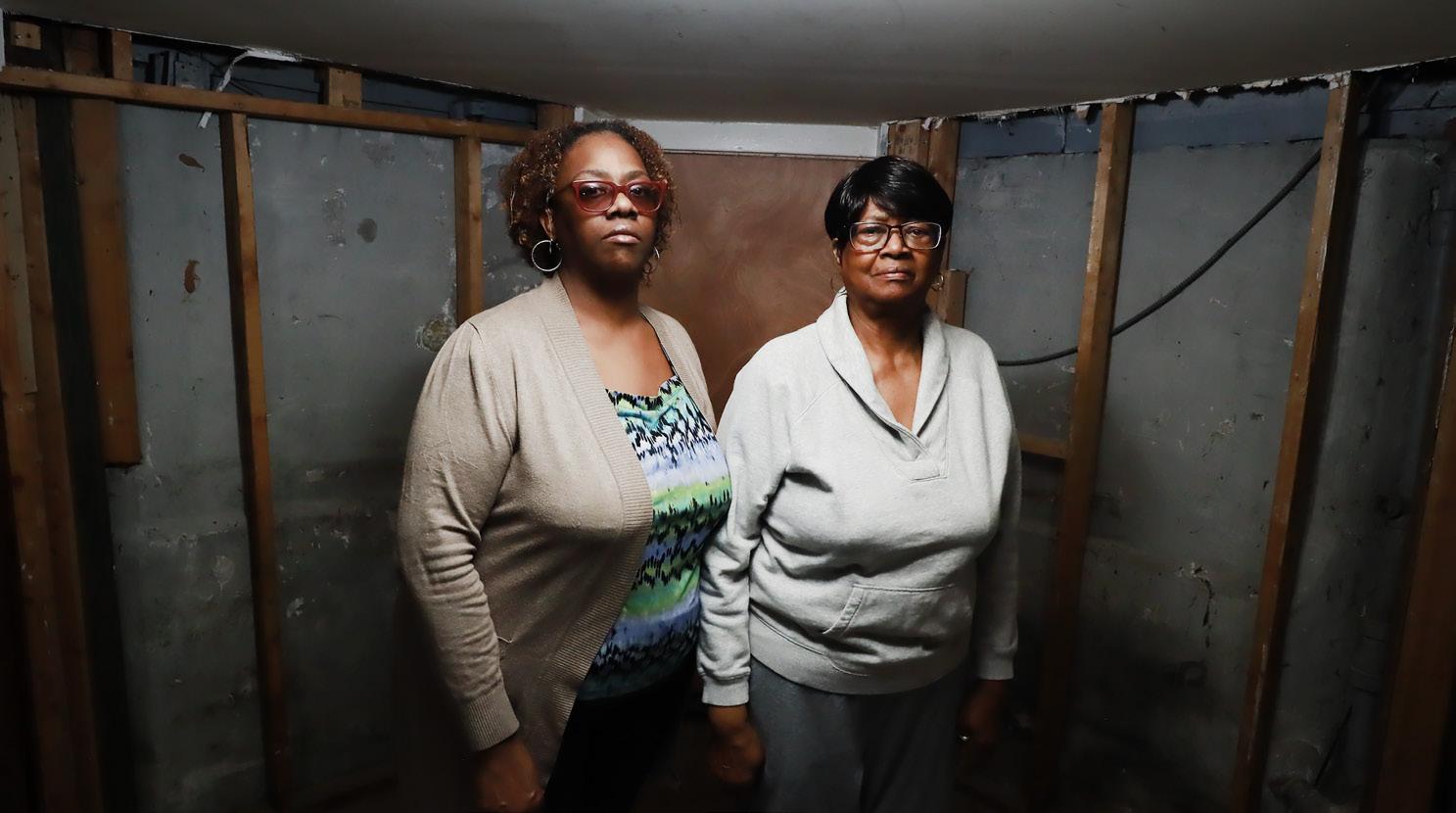
Princess also referred Mary to Team Rubicon, “a veteran-led humanitarian organization, built to serve global communities before, during, and after disasters and crises,” its website explains.
Team Rubicon removed the molded walls and virtually the entire bathroom in Mary’s basement at no cost.
“Those people — all I can say is they were amazing,” Mary says. “Princess got them to come in here. We called her at all times of the night and she answered her phone.”
Pleshette Spears and her mother, Mary Spears, 80, connected with Team Rubicon after attending a community meeting hosted by WHA.
“If it wasn’t for Westside Health Authority, I don’t know where we’d be right now,” Pleshette says. “We would still be living with mold.”
Jacqueline Crowther, an administrator with Every Block A Village, says for every Mary Spears, there are a dozen other Westsiders who are still living with mold and the health problems it brings. But without more funding and resources, there’s only so much the West Side LTRG can do to help.
“If it wasn’t for Westside Health Authority, I don’t know where we’d be right now. We would still be living with mold.”
“They came and sprayed and got most of the mold,” Mary says while standing in the basement of their home at 826 N. LeClaire in Austin. The basement apartment was home to Pleshette’s son and his family before the flooding happened.
“Before they took these walls down, there were gnats that would fly around in my apartment upstairs,” Mary says. “When Rubicon took the floor and walls out of the basement, everything stopped.”
“We have weekly calls with people from the city’s Office of Emergency Management and Communications and FEMA has helped us establish this organization but FEMA has not funded us,” Jacqueline says.
“Nobody is funding our efforts and nobody seems to care that people are suffering and have had mold in their basements for seven months and growing, with families who live in basements because this is a city where housing is expensive,” she says. “We need to understand why there’s money for everything else, but when it comes to people dying in their homes, senior citizens, vulnerable family members — [there is no] urgency.”

If you’re one of those people, like me, who still enjoys listening to vinyl, you gotta stop by Out of The Past Records at 4407 W. Madison St. in Austin. Just know this before you get there, Out of the Past is not your regular record store; it’s more like the Walmart or Sam’s Club of record stores. Also, make sure you plan ahead and have plenty of free time on your hands, because you could easily be there for a while.
In 1963, the late Charlie Henderson and his wife Marie opened a photography studio at 8 S. Pulaski in West Garfield Park. He was a big music fan, so they decided to put a record shop inside the photography studio and began selling records. The couple eventually opened and operated 10 record stores across the city.
“Back in those years on Fridays and Saturdays when people got paid, they would always buy records, because that was the thing back then,” Mary says.
After Charlie passed, the stores were consolidated into two locations before eventually merging into the current location at 4407 W. Madison St.
The store provides a family atmosphere and covers many genres of music, including
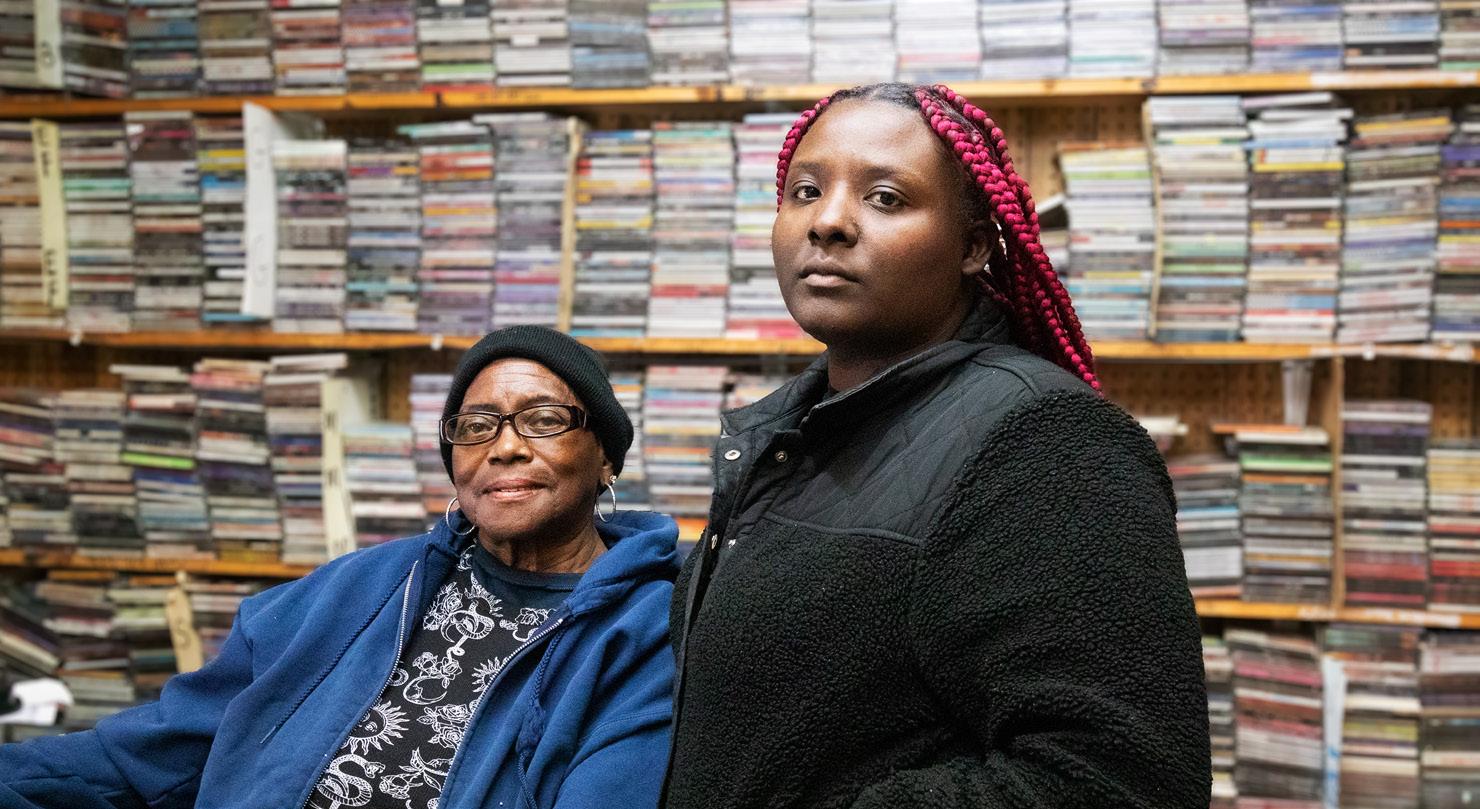
soul, jazz, blues, house and stepping music. The place is a paradise for people who like to dig around and find those treasured classics. By design, the store is not set up to display all the merchandise. One side is organized, and you can flip through the records listed by artists in alphabetical order. Another side, the fun side, is just rows and rows, and stacks and stacks of vinyl records separated by genres, so you must do your own digging around.
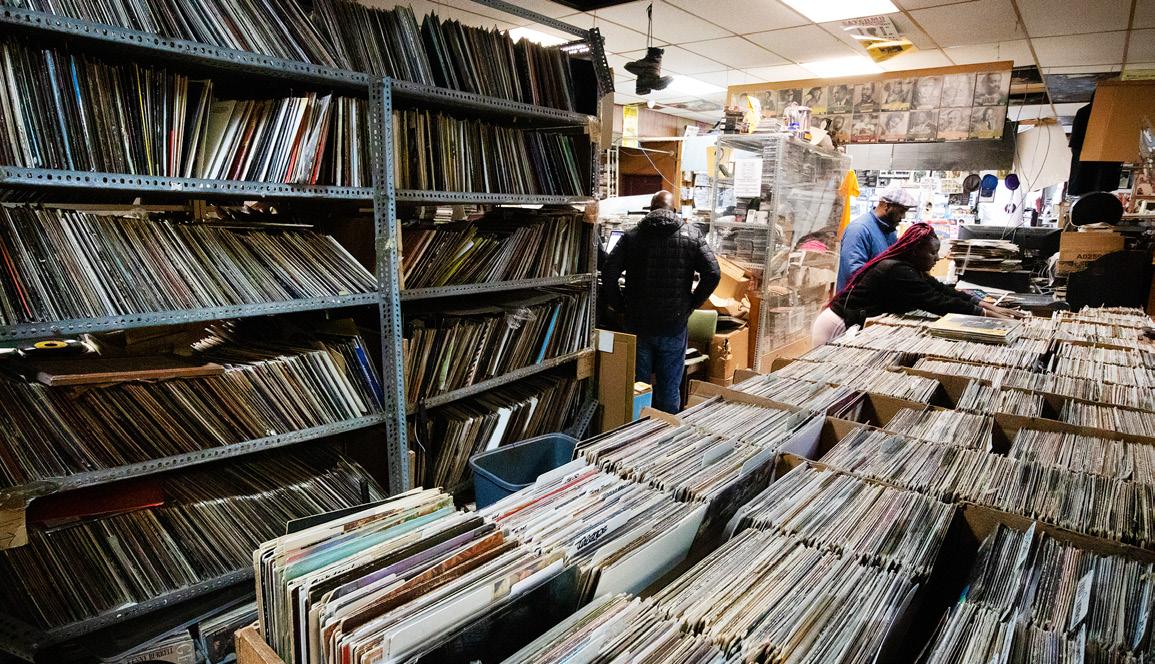
The store also has back rooms full of vinyl records that haven’t even reached the shelves yet. With so much merchandise, Out of The Past has attracted record-buyers from around the world.
“Before the pandemic I had a lot of buyers from overseas,” Mary says. “They would actually come in from Germany, England, France, Australia, Korea. We had a lot of buyers com-
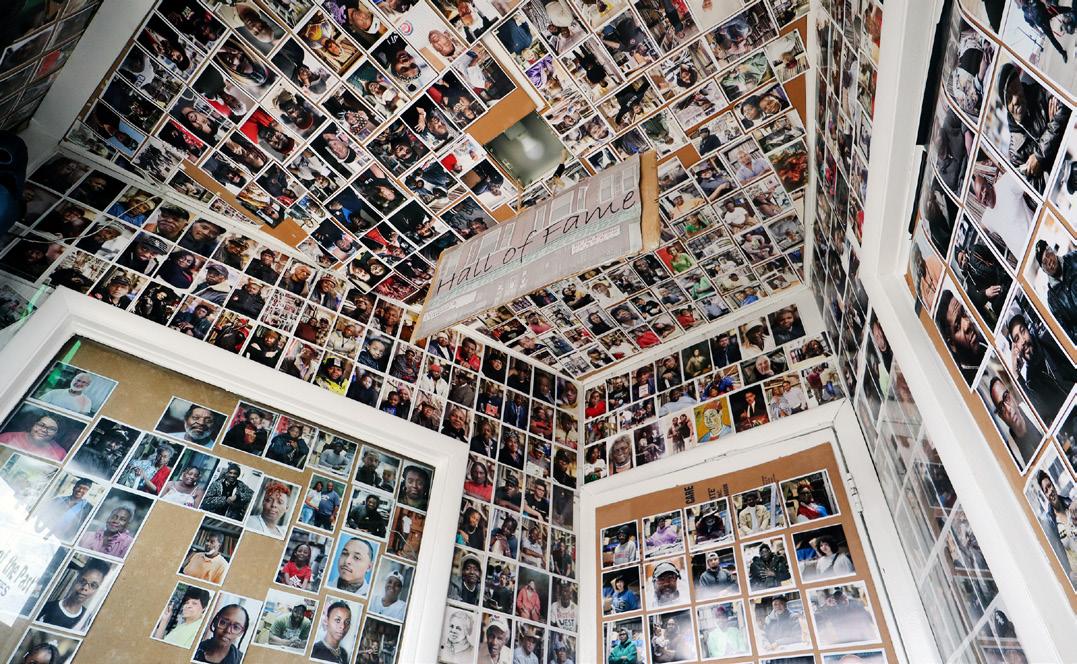
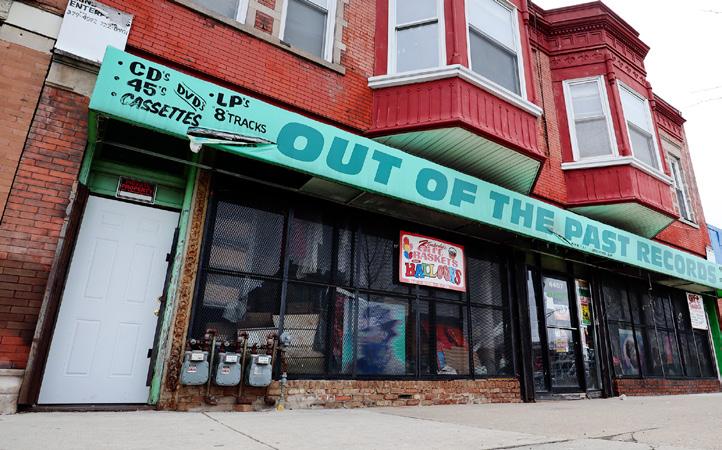
ing in. We just have an influx of good people that like their music. I’m kind of glad that they’re showing people LP’s again, because we’re getting a lot of young folks in and you’d be surprised at the amount of young people buying LP’s and 45’s.”
In addition to all the vinyl, Out of The Past also carries CD’s, cassette tapes and, believe it or not, eight-track tapes. Yes, they go back that far. As an additional service, you can also have your hard drive loaded with your favorite style of music.
They also have a turntable available, so you can listen to anything before you purchase it. This is the place where you can accidentally come across some of your favorite old school music. I found a couple classics laying around near the turntables.
Anissa Gooden, Marie’s granddaughter, has been around the store since she was a a baby. She now helps manage the store. She said sampling drew her deeper into music.
“What got me started is, I would hear a song from someone like Mary J Blige and the songs that they would sample from older artists,” Anissa says. “So, I would hear the original artists and think it was somebody else and that’s when my grandma would tell me, ‘No, that’s the original person.’”
Anissa says she sees people from all walks of life in the store and she knows most customers by name.
The first thing you see as you enter the store is a photo gallery put together by one of their customers, a retired photographer. He takes pictures of other customers and people from the community. They call it their ‘Wall of Fame.’
“They don’t play about that wall,” Anissa says. “They want to see their picture up. Most of the wall is filled with people from our community and now their kids and grandkids come in and shop with us, so it’s like a generational thing here.”

“I’m aware of the illness we have endured from the mold and I’m aware that people are dying because of the flood,” Ald. Emma Mitts (37th) says. “So, my whole body, mind and soul is [saying] ‘We need help’.”
Mitts says since last year’s flooding, she’s talked with city officials about infrastructure improvements, such as installing more detention ponds. But she’s urging government officials at every level to do more to fund residents’ more immediate needs, too.
“Most of the people whose basements flooded didn’t have [flood] insurance,” the alderwoman says. “They need drywall and new doors. There is a lot of stuff that needs to be done that volunteers can’t do. I’m not going to stop talking until every single one of us is made whole!”
Rep. La Shawn K. Ford (8th) also stresses the need for government officials to focus on both short-term and long-term fixes.
“We’ve learned that we need to make sure
MARCH 21 - APRIL 3
Thursday, March 21, 5 to 7 p.m., 5463 W. Division St. | Join Westside Health Authority for an Easter-themed Family Engagement Night featuring activities, food and custom t-shirt creation. For more info, call (312) 224-4753.
Friday, March 22, 1 p.m., Good Neighbor Center, 5437 W. Division St. | Join Westside Health Authority and the Good Neighbor Campaign us for Steppin’ with the Seniors featuring DJ Rockin Ron. Free entry, dance, food and fun. RSVP by calling (773) 786-0249. Call us if you need a ride.
Friday, March 22, 5 to 8 p.m., BUILD Chicago, 5100 W. Harrison St. | Join the 411 Movement in honor of Arewa Karen Winters’ nephew and the women who fight for justice. There will be
we push for infrastructure changes in these neighborhoods because infrastructure is so old that this is going to be a recurring problem,” Ford says. “We’re pushing for funding for flood prevention mechanisms for homeowners.”
Ford says he’s reserved $1 million in special appropriation funds so that additional funding can go to people who need more money on basement repairs and to fix potential code violations. Ford said the Illinois Department of Commerce and Economic Opportunity (DCEO) put out a request for competitive bids. Westside Health Authority (WHA) was awarded the bid.
“This grant funding will allow us to work in the 8th District to make whole people who experienced disrepair, code violations and all kinds of housing issues,” says Justin Hill, WHA’s policy analyst.
“We’ll open the window up for people to apply to be part of this. The grant will allow us to work with about 40 homes at roughly $25,000 to $30,000 each home to do those repairs. We’re not just removing mold or fixing stairwells; we’ll fix drainage systems, tile basins, sump pumps, etc. The question is how do we make home improvements that are long-lasting and will prevent the next big water issue here in Chicago.”
Ford says he’ll work to grow that $1 million grant by asking big businesses like The Home Depot and Lowe’s to pitch in.
“We hope the $1 million is a seed that grows,” he says. “We’ll show there’s probably 4,000 or more households in Austin alone that have been impacted and are still living with mold. There are still people right now probably without hot water.”
Ford, who lives in Austin, says he thinks about the community’s infrastructure crisis quite a bit. He’s directly affected by it.
“You talk about traumatized,” he says. “Rain is supposed to be beautiful. People are supposed to wish for rain for their grass and flowers. We have a real infrastructure problem. When it’s raining, I’m wondering whether or not I’ll go down to my basement and see it flooded. I’ve had three or four major floods in my basement since 1997.”
Congressman Danny K. Davis (7th), who also lives in Austin, says his basement was one of thousands across the city that flooded last year.
“I didn’t apply for any money because we were able to clean it out,” he says. “My son came over and cleaned it out. We got a good sump pump, but it just didn’t handle all that water.”
Davis says he’s still working with FEMA to get more money for disaster assistance.
“There’s still a possibility that people will
discussions on anti-police brutality movements with panelists.
Monday, March 25, noon to 2 p.m., Westside Health Authority Youth Development Center, 5465 W. Division St. | Join us for Service Day. For more info, call (312) 224-4753.
Tuesday, March 26, 9 a.m. to noon, Westside Health Authority Youth Development Center, 5465 W. Division St. | The WHA Youth Department will host a Chicago State University College Tour. For more info, call (312) 224-4753.
Tuesday, March 26, 12:30 to 1:45 p.m., Facebook Live | Join Austin Coming Together’s Hub 101: To Inspire and be Inspired with YourPassion1st.
Interested in being connected to resources that will help to empower our youth? For more info and/or to register, visit facebook.com/ACT.Chicago
Wednesday, March 27, noon to 2 p.m., Westside Health Authority Youth Development Center, 5465 W. Division St. | The WHA Youth Department will host Movie Day. For more info, call (312) 224-4753.
Thursday, March 28, noon to 2 p.m., Westside Health Authority Youth Development Center, 5465 W. Division St. | The WHA Youth Department will host Move Day (a day of recreation and dance). For more info, call (312) 224-4753.
Thursday, March 28, 2 to 4 p.m., Pop Grove, 4443 W. Madison St. (next to Three Crosses of Calvary
be able to get additional funding,” Davis says. “We’re steady pushing for another round and we’re talking to FEMA executives and people at the state level, saying to them there are people hurting and still in need. So, another round of funding is possible but we have to get the agreement and get more money. We’re still working. It’s not over.”
Of course, how much more funding, if more comes at all, depends on which party controls Congress — a point the longtime federal lawmaker isn’t shy about emphasizing.
““It’s no doubt about it,” he says. “Everything that exists, the Republicans are trying to cut because they don’t want to generate additional money. And, of course, the way to generate money would be to make the rich pay more and that’s why we increased the budget for the IRS [Internal Revenue Service]. So, they could hire experts to stop rich cheaters from cheating.”
Ford is urging lawmakers at all levels to pour more money into addressing the Westside’s inadequate infrastructure.
“Some of this [home improvement] work we’re doing and that residents have done — if the city, state and federal governments don’t come together for infrastructure improvements, we’d be just throwing money down the drain,” he says, “because the work will just have to be repeated after the next flood.”
Church) | Join WHA and Good Neighbor for an Easter Egg Family Pain & Sip featuring an easter egg hunt with prizes, music, snow cones and canvas paintings. For more info, call (312) 224-4753.
Friday, March 29, 1 to 5 p.m., BUILD Chicago, 5112 W. Harrison St. | Bring the family and Celebrate Easter with BUILD with an Easter Egg Hunt community event. There will be food, games, prizes, photos with the Easter Bunny and an Easter egg hunt. For more info, email Yesenia Garcia at yeseniagarcia@ buildchicago.org
To submit an event for inclusion in the community calendar, email mromain@healthauthority.org
Karl Brinson, the president of the Chicago Westside Branch NAACP and a member of the Moore Park Advisory Council, is a lifelong Westsider. His family moved to Austin in the late 1960s, when he was 11 years old and the community was still predominantly white. Racial tension was high as more Blacks moved here.
In his own words, Karl spoke about what he witnessed during his early years on the Westside and how the community, and its politics, evolved over time.
We were the second black family to move to the 5100 block of West Quincy in 1967. When we went to Columbus Park, we didn’t go individually, we went as a group for protection, for security and safety. They had a place up there in Columbus Park called ‘Devil’s Path’ and it used to be a little area where you would ride your bike through … and white guys would jump out of the bushes on you plus they would just bum-rush you if you went up to Columbus Park by yourself.
You always hear the phrase ‘white flight’ but it’s one thing to live ‘white flight.’ By us being that second [Black] house on the block, we didn’t even see the people when they were moving out. I’m being candid with you, the next time you wake up they gone. You wouldn’t see them packing up, having a party, saying, ‘Hey, we’re moving out!’ because you probably wasn’t that neighborly with each other.

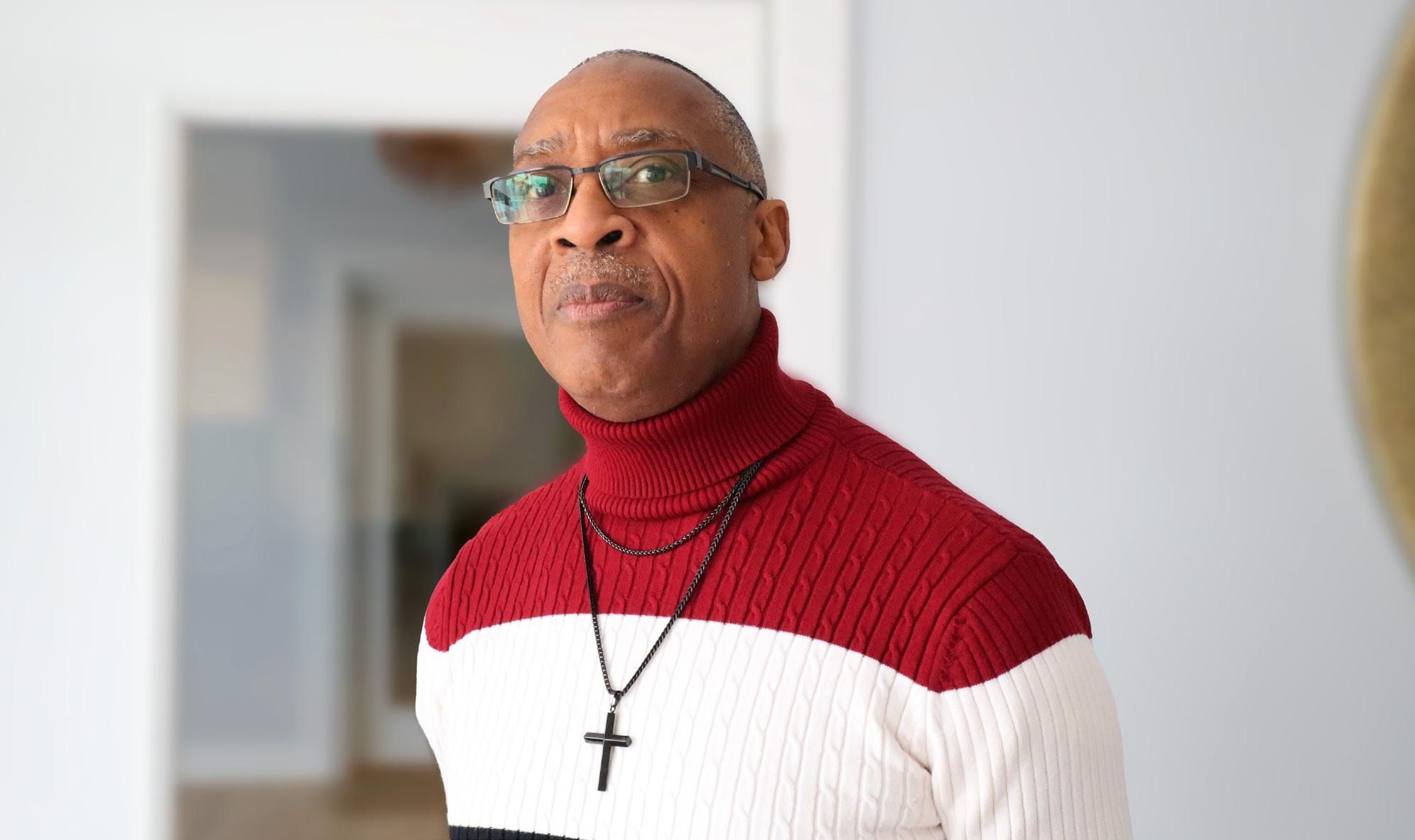
I watched how [the neighborhood] changed and who was in control of the politics back then. Our alderman was Leroy Cross and our ward committeeman was Willie Flowers. Both of them were Black, but the person who had the political power was Bernie Neinstein, a white Jewish guy. Neinstein ran the ward; he told them what to do; he was the one that got you the jobs.
They always called the wards in the Westside of Chicago the ‘Plantation Wards,’ because even though you had Black faces [by the 1980s, Austin was 75% Black], they were still ran by whites. The Jews and the Irish were still running the Westside of Chicago.
If you wanted to get a government job you had to get a letter from your committeeman, because that was part of the patronage system, that was part of the Democratic Party. That system is what helped make Chicago such a powerful city in terms of labor and industry.
When you went to get that letter [for a job], it did not come from Willie Flowers, it came from Bernie Neinstein. [Flowers] was just a figurehead. The demographic population had changed, so you had to put a Black face in place to influence the election turnout.
I remember watching how City Hall looked when Harold was there, the amount of young, Black professionals who were in positions at City Hall and then seeing [Mayor Richard M.] Daley come in. It went from Black faces walking up and down the hallways back to whites.
When you talk about how much has changed, not too much has changed, and it’s probably even gotten worse because most of our folks don’t even know their history. They think that what they’re doing now is something new and they don’t know what it looked like before, so they have nothing to base success on, especially when it comes to politics on the Westside.
When you’re with the machine you’re looking for promotions, you’re looking for jobs, you’re looking for job security, you’re looking to have access to the perks that come with being part of the Democratic Party.
When I joined the independent movement, I didn’t get paid a dime to work them polls and go ring doorbells. I was fighting against something. I wanted to change the system and break the Machine and try to change the way they did business in Chicago. I did it because I believed in something; I wasn’t promised something, I was just trying to change something.
Air Traffic Controllers | The Federal Aviation Administration (FAA) announced last month that it’s working to accelerate its training and hiring of air traffic controllers.
Applications open June 24 through June 27, so if you know someone between 18 and 30 looking for work, tell them to go to faa.gov/ be-atc. The salary ranges between $103,000 and $164,000 per year and they pay for your training and school.
One Summer Chicago | Summer jobs for Westside youth ages 16 to 24 are returning again. The deadline to apply for them is May 3. Applications are now open at onesummerchicago.org.

• Step 1: Click on the big red button (summer jobs), click on the big gray button (apply), click on the word “Register” underneath the log-in box and fill out the application BUT write down you EMAIL and PASSWORD.
• Step 2: Page 4 is very important. Make sure the ONLY box checked is for: Chicago Department of Family and Support Services (otherwise we cannot hire you).
- Next question: “Is there a particular agency you want to work with? Please click on: Westside Health Authority.
• Step 3: At the bottom of Page 6: Check the box: Yes I Agree. After you have completed and submitted your application, please write down
If you are skilled at drawing, painting, or coming up with creative images or slogans, you may want to consider a career in Graphic Design.
Most likely you encounter the work of a Graphic Designer multiple times per day. Whenever you see a company logo that you recognize, the imagery that appears on your
your OSC Application ID #. We’ll be asking you for that. After you have completed your online application, please email Mrs. Flowers at jflowers@healthauthority.org
• Step 4: Starting April 1 through June 21, come to Westside Health Authority (5465 W. Division St.), 10 a.m. to 5 p.m. Make sure you bring all your paperwork: ID, Social Security Number (SSN) card and birth certificate (We also take school ID’s). If you have a driver’s license or state ID, we do not need your birth certificate. No applications will be accepted without your Social Security card and ID.
Mistica Foods | Westside Health Authority, Specialized Staffing
Solutions Inc. and Mistica Foods, a background-friendly employer, are recruiting workers for a range of temporary positions, including:
• General labor
• Machine operators
• Walkie riders
• Quality control technicians
• Forklift drivers
• And much more Eligiblity requirements include:
• Reliable transportation
• The ability to work in a cold environment
• The ability to work in a fast-paced environment
• A Social Security card and Illinois-issued ID/driver’s license
For more info or to send a resume,

device as you’re streaming your favorite music, or opening the package of your favorite snacks, are all examples of the work of Graphic Designers.
Visual communication is now more important than ever. Graphic Designers use
imagination and creativity to develop visual concepts that capture our attention, inspire and inform others. They use images, text, color and typography to communicate messages or ideas.
Graphic Designers are responsible for developing the layout and design of the images we see on websites, print and digital advertisements, and social media platforms.
email jgreen@healthauthority.org or call (312) 224-4736 (Ext. 2110).
Austin Coming Together Case Manager | Austin Coming Together, a Westside nonprofit that offers support for a variety of local organizations, is hiring a full-time Case Manager. This person will be responsible for engaging Austin residents and stakeholders through the Austin Community Hub fand facilitating coordinated intake and referral with participants and partners, among other responsibilities. Salary is commensurate with experience and ranges from $50,000 to $55,000 plus benefits. For more info or to apply, visit austincomingtogether.org/ case-manager/
You’ll need to be proficient in industry-standard software such as Adobe Photoshop, Illustrator and In-Design, so it may be a good idea to start familiarizing yourself with these tools.
Collaboration is also a big part of the profession since Graphic Designers often work in teams of other professionals including writers, other designers and developers to bring their ideas to life. As with most careers, being a team player is important. Developing sharp listening skills, being able to accept critical feedback and make the necessary adjustments or edits are important if you want to get far as a Graphic Designer.
Timeliness is another key element of the profession since work schedules generally revolve around deadlines and deliverables.
Most, but not all, employers require at least a bachelor’s degree to enter the profession. However, you will need a portfolio of your work to demonstrate your level of skill, creativity and expertise.
According to the U.S. Bureau of Labor Statistics the median salary for Graphic Designers is close to $60,000 both nationally and here in the Chicago area, but many top designers earn much more. If this career is of interest to you, sharpen your skills and go for it!
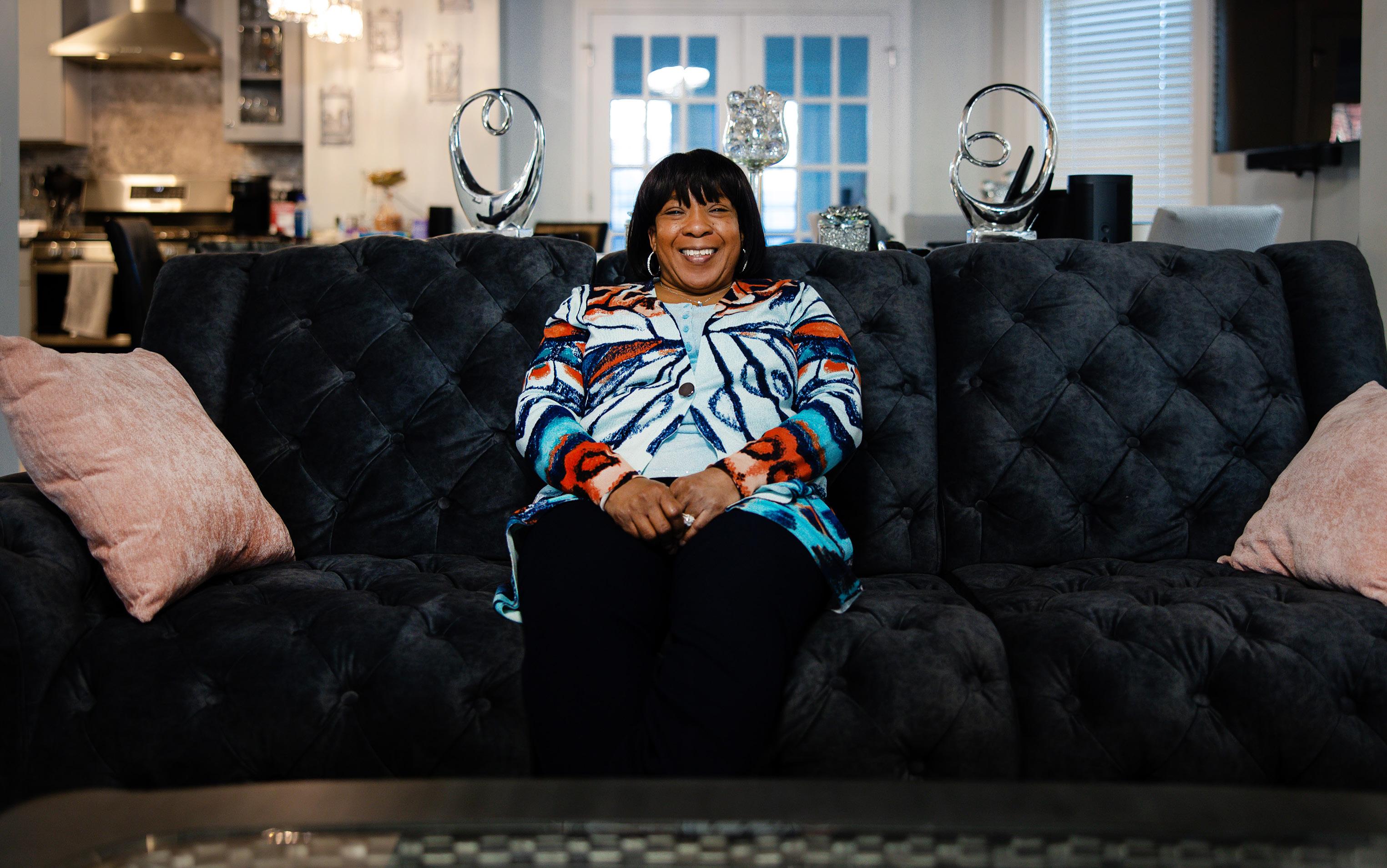
Austin resident and community leader Cata Truss in her home.
We spoke to her recently for a Westside Lives profile that will run in our next issue.

Have a story to tell us?
Email: mromain@healthauthority.org